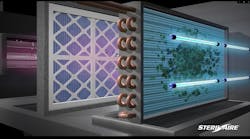A few years back, one of my clients was a well-known engineering firm in New York City. My work for the firm consisted of engineering oversight on projects the partner in charge did not have sufficient time to properly supervise himself. During the period I was doing this work, one of the firm's projects was a major addition to a well-known art museum in the city.
One cold winter day when I was working at the engineering firm's office, a frantic call came from the director of the museum. No one in charge was present, so I took the call. The director said water was streaming “like a waterfall” down a large window that occupied an entire end wall of the main gallery. Something had to be done immediately to avert damage to priceless works of art.
Upon arrival, I found that water was indeed running down the window. The source was condensation on the cold glass surface exposed to the humidified air in the gallery. There was a linear supply register above the window obviously for the purpose of blanketing the window surface with dry air to prevent the condition that was evident before us. A quick check with my hand disclosed that no air was flowing out of the supply register.
Problem solved?
Not so fast.
The air source for the supply register was a dedicated air-handling unit. The unit was located in a utility room that was used by the electrical trade for storage and as an office for the electrical-union local official. The union official stopped the supply fan because he did not like the sound produced by the fan in “his” room.
The function of the air handler and the need for it to run was carefully explained to the union official, whose response was that if anyone started the fan, he would pull all of the electrical workers off the job. With electrical work behind schedule, that would have shut down the whole job. The museum director was in a panic. The date for the museum's grand opening had been set long ago. The guest list included dignitaries from the city, state, and federal governments; major museum contributors; industry sponsors; and luminaries of the international art world. A live television program was scheduled. Delay of completion was not an option.
A top-level meeting quickly was arranged. It was attended by the chairman of the board of trustees; the director and managing partner of the engineering firm; a representative from the mayor's office; and the national president of the electrical-worker's union. The meeting was behind closed doors, and we can only imagine who said what to whom. But when the meeting was over, the air-handling unit was started. Condensation stopped. The electricians continued working and finished the job on time. The museum had its grand opening as scheduled. Very few knew how close the ceremonies came to being halted. But all's well that ends well.
Bertram Waller, PE
Stamford, Conn.
Send “war stories” of 400 words or less to Scott Arnold, managing editor, at [email protected]. Authors are paid $50 per published war story.








